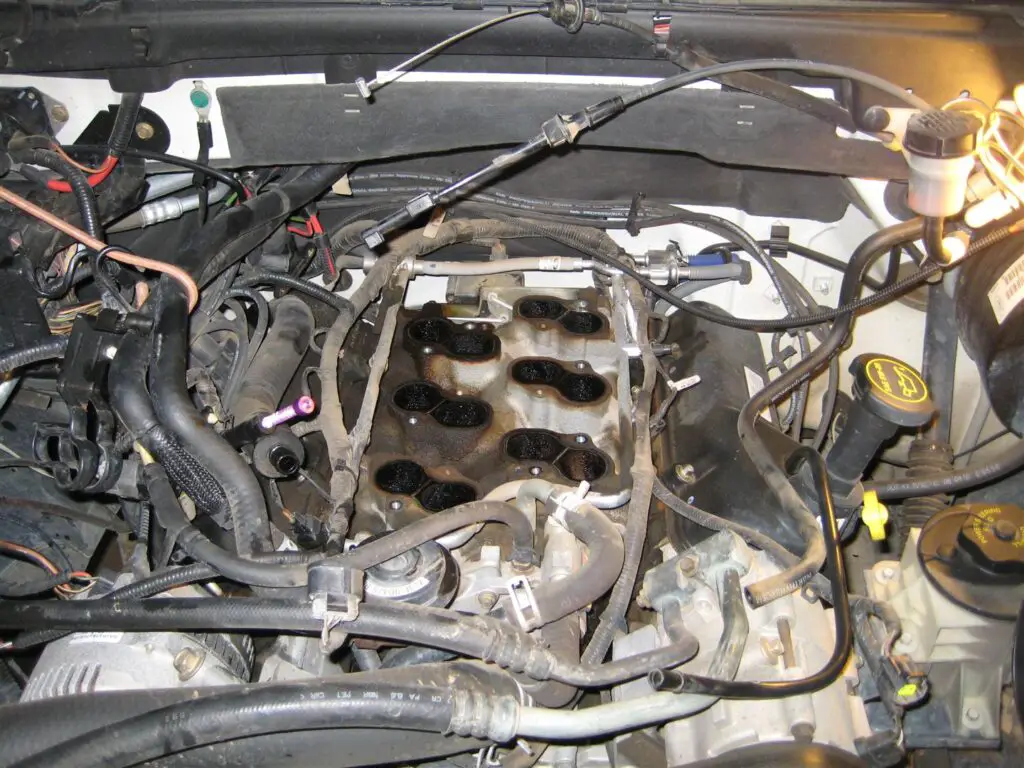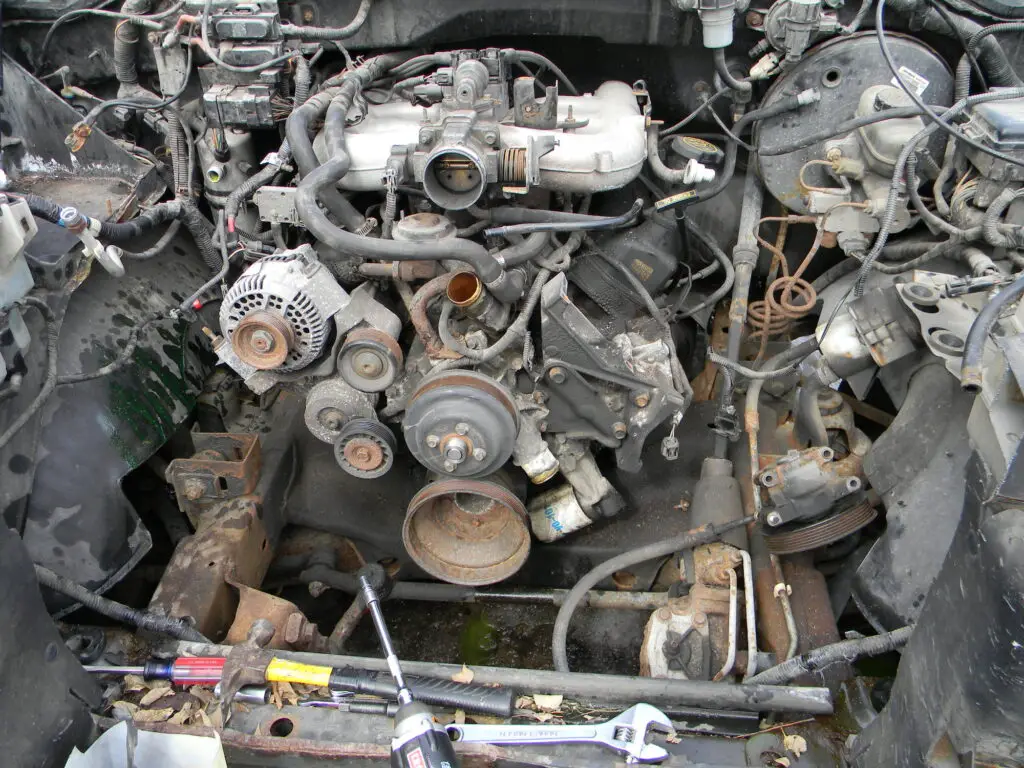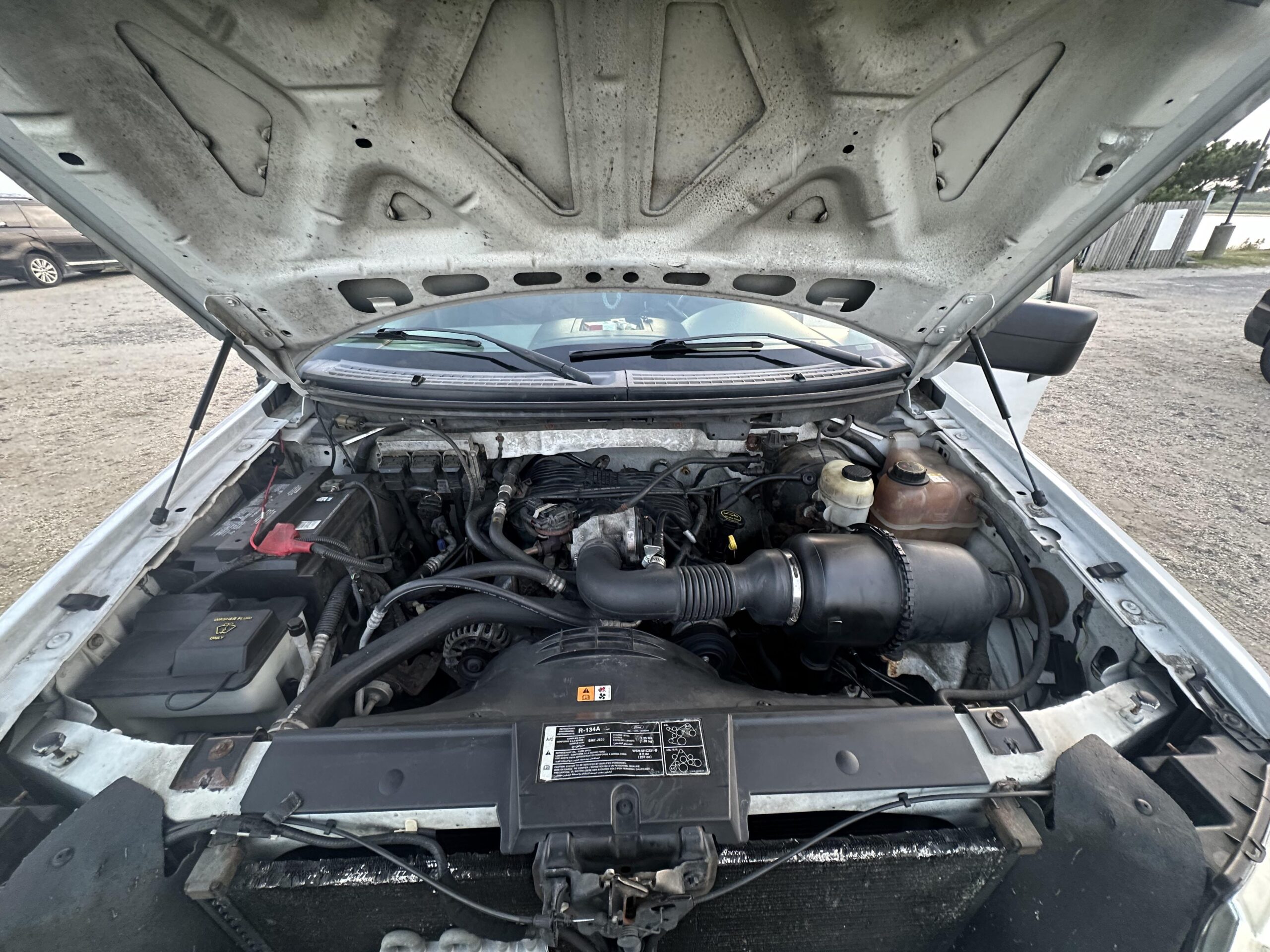The Ford 4.2L V6 engine has been a staple in many Ford vehicles since its introduction in 1997. This powerplant, also known as the Canadian Essex V6, was primarily used in Ford F-150 trucks, Ford E-Series vans, and the Ford Explorer SUV.
| Problem | Symptoms | Cause | Prevention/Solution |
|---|---|---|---|
| 1. Intake Manifold Gasket Failure | – Coolant leaks – Overheating – White smoke from exhaust – Poor engine performance | – Low-quality gasket material (paper) – High temperature and pressure | – Replace with better gaskets – Monitor coolant levels |
| 2. Timing Chain Tensioner Issues | – Rattling noise at cold starts – Engine misfires – Potential engine damage | – Inadequate oil pressure at startup – Premature tensioner wear | – Regular oil changes – Use high-quality oil |
| 3. Oil Leaks | – Oil puddles under vehicle – Burning smell – Smoke from engine bay | – Worn valve cover gaskets – Faulty oil pan gasket – Damaged main seals | – Replace affected gaskets/seals – Check for leaks regularly |
| 4. Exhaust Manifold Cracks | – Ticking noise (when cold) – Exhaust leak smell – Check Engine Light | – Constant heating/cooling cycles – Heavy-duty use/towing | – Replace cracked manifold – Consider upgraded design |
| 5. EGR System Problems | – Rough idling – Stalling – Poor acceleration – High emissions | – Carbon deposits in EGR valve and passages – Low-quality fuel | – Use fuel additives – Maintain proper service schedule |
| 6. Spark Plug & Ignition Coil Failures | – Engine misfires – Rough running – Reduced fuel economy – Check Engine Light | – Heat-related coil failures – Fouled or damaged plugs | – Replace faulty components – Be careful when removing old plugs |
| 7. Mass Airflow Sensor Issues | – Poor fuel economy – Hesitation or stalling – Black smoke from exhaust – Hard starting | – Sensor contamination – Exposure to dirt and oil vapors | – Clean sensor carefully – Replace if cleaning doesn’t work |
| 8. Water Pump Failure | – Coolant leaks (front of engine) – Overheating – Steam from radiator – Whining noise | – Worn bearings – Damaged impeller | – Replace water pump – Don’t confuse with intake gasket issue |
| 9. Oil Sludge Buildup | – Reduced oil pressure – Accelerated component wear – Potential engine seizure | – Irregular oil changes – Low-quality oil | – Use high-quality synthetic oil – Follow recommended change intervals |
Key Takeaways:
- Many issues relate to gaskets, seals, and cooling system
- Regular maintenance is crucial (oil changes, coolant checks)
- Listen for unusual noises, they often indicate problems
- Some issues (like manifold cracks) more common in heavy-duty use
- Later models addressed some design flaws
While it has proven to be a durable engine for many owners, it’s not without its share of problems. In this blog post, we’ll dive deep into the most common issues that plague the Ford 4.2L V6 engine.
Engine Overview
Before we delve into the problems, let’s understand the engine itself. The Ford 4.2L V6 is a 90-degree V6 engine with a displacement of 256 cubic inches (4.2 liters). It features an iron block and iron heads, making it quite heavy but also very durable. This engine was designed to provide a good balance between power and fuel economy, producing between 200 and 225 horsepower, depending on the vehicle and year.
1. Intake Manifold Gasket Failure
One of the most notorious issues with the 4.2L V6 is the failure of the intake manifold gaskets. The gaskets are responsible for sealing the connection between the intake manifold and the cylinder heads, preventing coolant and air leaks. In the Ford 4.2L V6, these gaskets are prone to deterioration over time.
When the gaskets fail, you may notice:
- Coolant leaks
- Overheating issues
- White smoke from the exhaust
- Poor engine performance
The root cause is often the material used for the gaskets. Ford initially used paper gaskets, which break down under high temperatures and pressure. Later models switched to more durable materials, but many older engines still suffer from this problem.
2. Timing Chain Tensioner Issues
Another common problem is related to the timing chain tensioner. The 4.2L V6 uses a timing chain instead of a belt, which is generally more durable. However, the chain tensioner can fail prematurely, leading to a rattling noise from the front of the engine, especially during cold starts.
If left unaddressed, a faulty tensioner can cause:
- Chain slippage
- Engine misfires
- Potential catastrophic engine damage if the chain skips teeth
The issue is often due to inadequate oil pressure at startup, which fails to properly lubricate and pressurize the tensioner. Regular oil changes with high-quality oil can help prevent this problem.
3. Oil Leaks

Oil leaks are another headache for 4.2L V6 owners. These engines are notorious for developing leaks as they age, particularly from:
- Valve cover gaskets
- Oil pan gasket
- Front and rear main seals
The valve cover gaskets are often the first to go, leading to oil dripping onto the exhaust manifold, causing a burning smell and potential smoke. The oil pan gasket can also fail due to its location, which is subjected to road debris and temperature changes. Main seal leaks are more serious and often require removing the transmission (rear seal) or the timing cover (front seal) to replace.
4. Exhaust Manifold Cracks
The exhaust manifolds on the 4.2L V6 are prone to cracking, particularly on the passenger side. This issue is more common in trucks and vans that see heavy-duty use or frequent towing. Symptoms include:
- Ticking noise, especially when the engine is cold
- Exhaust leak smell
- Check Engine Light due to O2 sensor readings
The cracks develop due to the constant heating and cooling cycles the manifolds undergo. The problem is exacerbated by the engine’s torque and the weight of the manifold itself. Ford revised the design in later years, but many older models still suffer from this issue.
5. EGR System Problems

The Exhaust Gas Recirculation (EGR) system is designed to reduce nitrogen oxide emissions by recirculating a portion of exhaust gases back into the intake. In the 4.2L V6, the EGR valve and passages can become clogged with carbon deposits.
This leads to:
- Rough idling
- Stalling
- Poor acceleration
- Increased emissions
The problem is often worse in engines that frequently operate under low-load conditions or have a history of using low-quality fuel. Regular use of fuel additives and maintaining a proper maintenance schedule can help prevent EGR issues.
6. Spark Plug and Ignition Coil Failures
While not unique to the 4.2L V6, ignition system problems are quite common. The engine uses a coil-on-plug design, where each spark plug has its own ignition coil. This design eliminates the need for spark plug wires but makes each coil more susceptible to heat-related failures.
Symptoms include:
- Engine misfires
- Rough running
- Reduced fuel economy
- Check Engine Light
The spark plugs themselves can also fail prematurely or become fouled. In some cases, the plugs can be difficult to remove without breaking, especially in high-mileage engines, due to carbon buildup or thread damage.
7. Mass Airflow Sensor Issues
The Mass Airflow (MAF) sensor is critical for the engine’s computer to determine the correct air-fuel ratio. In the 4.2L V6, the MAF sensor can become contaminated or fail outright. This is often due to its location in the air intake system, where it’s exposed to dirt and oil vapors.
A faulty MAF sensor causes:
- Poor fuel economy
- Hesitation or stalling
- Black smoke from the exhaust
- Difficulty starting
Many owners find that carefully cleaning the MAF sensor with specialized cleaner can resolve the issue, but replacement is sometimes necessary.
8. Water Pump Failure
Water pump issues are more prevalent in higher-mileage 4.2L V6 engines. The water pump is responsible for circulating coolant through the engine, and its failure can lead to severe overheating. Signs of a failing water pump include:
- Coolant leaks at the front of the engine
- Overheating
- Steam from the radiator
- A whining noise from the pump
The problem often stems from worn bearings or a damaged impeller. In some cases, a leaking water pump can be mistaken for an intake manifold gasket issue, so proper diagnosis is crucial.
9. Oil Sludge Buildup
While not as common as some other issues, oil sludge buildup can be a severe problem in neglected 4.2L V6 engines. Sludge forms when oil is not changed regularly, breaking down and combining with contaminants to form a thick, tar-like substance.
Oil sludge can lead to:
- Oil passages blockage
- Reduced oil pressure
- Accelerated wear on bearings and other components
- Engine seizure in extreme cases
This issue is more common in engines that have seen irregular oil changes or have been run on low-quality oil. Using high-quality synthetic oil and adhering to Ford’s recommended oil change intervals can prevent this problem.
Conclusion
The Ford 4.2L V6 engine, while robust in many ways, does have its share of problems. Many of these issues stem from design choices that prioritized cost over longevity, particularly in earlier production years. However, it’s important to note that not all 4.2L V6 engines will experience these problems, and many have proven to be reliable workhorses.
Regular maintenance is key to prolonging the life of your Ford 4.2L V6:
- Change oil regularly with high-quality synthetic oil
- Replace coolant and other fluids as recommended
- Address any leaks promptly
- Listen for unusual noises and investigate immediately
If you own a vehicle with this engine, being aware of these common issues can help you catch problems early, saving you from more expensive repairs down the line.
Also Read:
- Ford 3.5L V6 EcoBoost Engine Problems: A Comprehensive Analysis
- Ford 5.4 Engine Problems: A Deep Dive into America’s Workhorse
- What’s the Real Cost of Replacing a Toyota RAV4 Hybrid Battery?
- Piston Ring Replacement Cost: What to Expect for Your Vehicle
Despite its flaws, the 4.2L V6 has served many Ford owners well, especially those who have maintained their engines meticulously.


[…] Ford 4.2L V6 Engine Problems: A Comprehensive Guide […]
[…] Ford 4.2L V6 Engine Problems: A Comprehensive Guide […]
[…] Ford 4.2L V6 Engine Problems: A Comprehensive Guide […]